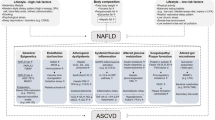Abstract
Background
Recently, the upper limits of normal (ULN) for alanine-aminotransferase (ALT) has been recommended to be lowered to ≤30 U/l in men and ≤19 U/l in women.
Aim
To evaluate the ALT concentrations in a healthy Middle Eastern population with biopsy-proven normal liver tissue.
Methods
ALT values were calculated from 175 consecutive Saudi potential living liver donors who underwent a liver biopsy as part of a stepwise pretransplant workup.
Results
The mean age of the 110 potential donors with normal liver histology was 27 ± 6.2 years for men and 38.6 ± 7.1 years for women. The mean body mass index (BMI) levels were 23.0 ± 3.5 kg/m2 for men and 24.7 ± 3.25 kg/m2 for women, and the ALT levels were higher in male patients (22.6 ± 9 vs. 16.4 U/l ± 8, p value = 0.003). Multivariate linear regression showed that BMI and sex were independent variables that were positively associated with the levels of ALT (p < 0.0001). Moreover, when we analyzed donors according to the Prati criteria, 63 (36.0 %) of the individuals were classified into this subgroup. The mean ALT concentration was 12.9 U/l ± 4.5 in women and 19.7 U/l ± 6.9 in men, and these values were significantly lower than those obtained from subjects who did not fit the Prati criteria (19.4 U/l ± 1.8, p = 0.04 for women and 29.0 U/l ± 12.1, p = <0.0001 for men). Thus, we calculated healthy ALT values of 33 IU/l for men and 22 IU/l for women.
Conclusions
The ULN for ALT levels in Middle Eastern populations should be lowered, including separate values for males and females. Furthermore, metabolic parameters were shown to have a significant effect on ALT levels.

Similar content being viewed by others
References
Pratt DS, Kaplan MM. Evaluation of abnormal liver-enzyme results in asymptomatic patients. N Engl J Med. 2000;342:1266–1271.
Kaplan MM. Alanine aminotransferase levels. What’s normal? Ann Intern Med. 2002;137:49–51.
Lazo M, Clark JM. The epidemiology of nonalcoholic fatty liver disease: a global perspective. Semin Liver Dis. 2008;28:339–350.
Amarapurkar DN, Hashimoto E, Lesmana LA, et al. How common is non-alcoholic fatty liver disease in the Asia-Pacific region and are there local differences? J Gastroenterol Hepatol. 2007;22:788–793.
Prati D, Taioli E, Zanella A, et al. Updated definitions of healthy ranges for serum alanine aminotransferase levels. Ann Intern Med. 2002;137:1–10.
Sanai FM, Helmy A, Dale C, et al. Updated thresholds for alanine aminotransferase do not exclude significant histological disease in chronic hepatitis C. Liver Int. 2011;31:1039–1046.
Keeffe EB, Dieterich DT, Han SH, et al. A treatment algorithm for the management of chronic hepatitis B virus infection in the United States: 2008 update. Clin Gastroenterol Hepatol. 2008;6:1315–1341.
Lee JK, Shim JH, Lee HC, et al. Estimation of the healthy upper limits for serum alanine aminotransferase in Asian populations with normal liver histology. Hepatology. 2010;51:1577–1583.
Ioannou GN, Boyko EJ, Lee SP. The prevalence and predictors of elevated serum aminotransferase activity in the United States in 1999–2002. Am J Gastroenterol. 2006;101:76–82.
Kariv R, Leshno M, Beth-Or A, et al. Re-evaluation of serum alanine aminotransferase upper normal limit and its modulating factors in a large-scale population study. Liver Int. 2006;26:445–450.
Mohamadnejad M, Pourshams A, Malekzadeh R, et al. Healthy ranges of serum alanine aminotransferase levels in Iranian blood donors. World J Gastroenterol. 2003;9:2322–2324.
Lozano M, Cid J, Bedini JL, Mazzara R, et al. Study of serum alanine-aminotransferase levels in blood donors in Spain. Haematologica. 1998;83:237–239.
Vernon G, Baranova A, Younossi ZM. Systematic review: the epidemiology and natural history of non-alcoholic fatty liver disease and non-alcoholic steatohepatitis in adults. Aliment Pharmacol Ther. 2011;34:274–285.
Al-hamoudi W, El-Sabbah M, Ali S, et al. Epidemiological, clinical, and biochemical characteristics of Saudi patients with nonalcoholic fatty liver disease: a hospital-based study. Ann Saudi Med. 2012;32:288–292.
El-Hassan AY, Ibrahim EM, Al-Mulhim FA, Nabhan AA, Chammas MY. Fatty infiltration of the liver: analysis of prevalence, radiological and clinical features and influence on patient management. Br J Radiol. 1992;65:774–778.
Fan JG, Saibara T, Chitturi S, et al. What are the risk factors and settings for non-alcoholic fatty liver disease in Asia-Pacific? J Gastroenterol Hepatol. 2007;22:794–800.
Kim HJ, Kim HJ, Lee KE, et al. Metabolic significance of nonalcoholic fatty liver disease in nonobese, nondiabetic adults. Arch Intern Med. 2004;164:2169–2175.
Flegal KM, Carroll MD, Kit BK, Ogden CL. Prevalence of obesity and trends in the distribution of body mass index among US adults, 1999–2010. JAMA. 2012;307:491–497.
Al-Nozha MM, Al-Maatouq MA, Al-Mazrou YY, et al. Diabetes mellitus in Saudi Arabia. Saudi Med J. 2004;25:1603–1610.
Al-Nozha MM, Al-Mazrou YY, Al-Maatouq MA, et al. Obesity in Saudi Arabia. Saudi Med J. 2005;26:824–829.
Piton A, Poynard T, Imbert-Bismut F, et al. Factors associated with serum alanine transaminase activity in healthy subjects: consequences for the definition of normal values, for selection of blood donors, and for patients with chronic hepatitis C. MULTIVIRC Group. Hepatology. 1998;27:1213–1219.
Ruhl CE, Everhart JE. Trunk fat is associated with increased serum levels of alanine aminotransferase in the United States. Gastroenterology. 2010;138:1346–1356, 1356.e1–1356.e3.
Kunde SS, Lazenby AJ, Clements RH, Abrams GA. Spectrum of NAFLD and diagnostic implications of the proposed new normal range for serum ALT in obese women. Hepatology. 2005;42:650–656.
Chalasani N, Younossi Z, Lavine JE, et al. The diagnosis and management of non-alcoholic fatty liver disease: practice guideline by the American Gastroenterological Association, American Association for the Study of Liver Diseases, and American College of Gastroenterology. Gastroenterology. 2012;142:1592–1609.
Conflict of interest
None.
Author information
Authors and Affiliations
Corresponding author
Rights and permissions
About this article
Cite this article
Al-hamoudi, W., Ali, S., Hegab, B. et al. Revising the Upper Limit of Normal for Levels of Serum Alanine Aminotransferase in a Middle Eastern Population with Normal Liver Histology. Dig Dis Sci 58, 2369–2375 (2013). https://doi.org/10.1007/s10620-013-2659-0
Received:
Accepted:
Published:
Issue Date:
DOI: https://doi.org/10.1007/s10620-013-2659-0




